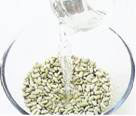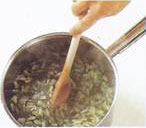 |
|
|
|
|
| Soup | Appetizers | Egg & cheese | Fish & shell fish | Poultry & game | Meat | Vegetables | More ... | |||||||
VEGETABLE STOCKAdd any vegetable trimmings you have (celery tops or tomato skins, Jar-example) or vary the ingredients to emphasize the flavor oj the dish in which you want to use the stock. 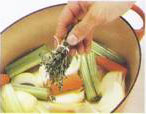
1 Coarsely chop 2 onions, 2-3 carrots, 3 celery stalks, and 1 leek. Put into a large saucepan or stockpot and add 1 large bouquet garni. Add 1 crushed garlic clove too, if desired. 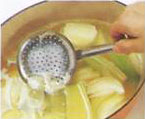
2 Add 5 cups (1.25 liters) water and bring to a boil. Skim off any foam that rises to the surface. Lower the heat and simmer for 30 minutes. 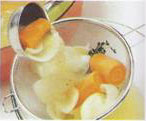
3 Pour the stock through a strainer. If not using immediately, leave to cool, cover, and store in the refrigerator for up to 5 days or in the freezer for up to 1 month. VEGETARIAN KNOW-HOWTHERE ARE THREE BASIC types of vegetarian diet. A vegan diet is the strictest - vegans do not eat any meat, fish, eggs, or dairy products. A vegetarian diet excludes meat, poultry, and fish and mayor may not include eggs and dairy products. A semi-vegetarian diet can include fish and poultry. With such a great variety of foods from which to choose, vegetarian diets, based largely on complex carbohydrates, legumes, vegetables, fruits, nuts, and seeds, can be both imaginative and nutritious. MAINTAINING A BALANCED DIETFish, meat, poultry, dairy products, and eggs are "complete" protein foods, which means that they contain almost all the essential dietary amino acids that the body needs. Many vegetarians replace fish, meat, and poultry with eggs, cheese, and other dairy products, but this is not the ideal solution since dairy foods are high in saturated fats and calories. Instead, complete protein can be obtained by combining two or more vegetable protein sources, or adding nonanimal complete protein foods to the diet, such as tofu and TVP (textured vegetable protein). Legumes, grains, nuts, and seeds, although rich in protein, are deficient in one or more of the essential amino acids, but combining vegetable protein sources makes the protein complete. Examples of complete vegetarian protein combinations drawn from cuisines around the world are beans and rice, hummus and pita bread, or a mixed nut, lentil, and vegetable salad. Another dietary interaction that vegetarians should be aware of is that between iron and vitamin C. The form of iron found in meat is easily absorbed by the body, but the iron in vegetables, nuts, grains, legumes, and eggs needs a helping hand, and this is provided by vitamin C. Be sure to include a green vegetable, tomatoes, or citrus fruit when serving these foods. ALTERNATIVE PROTEIN FOODSTofu TVP are complete protein Joods that are low in Jat, calories, and cholesterol and so make a healthy basis Jar a great variety oj dishes. 
Made from processed, pressed soybeans, tofu has no taste of its own (unless it is the smoked variety), but it quickly takes on the flavors of marinades and sauces. It contains no fat. Silken tofu has a soft, creamy texture: use it in sauces, dips, and desserts. Firm tofu can be stir-fried, broiled, or used in casseroles. Before use, drain and pat dry with paper towels. TVP
Textured vegetable protein, or TYP, is made from soy flour and is virtually fat free. It is available as chunks or "ground" and has a rather chewy texture, like meat. It is often used in commercial vegetarian products such as sausages. It keeps well, so keep a pack in your cabinet and use it in homemade burgers or cook it in a stew or casserole. Gelatin is a natural protein found in the bones, skin, and connective tissues of animals. Commercial powdered gelatin is derived from pig skin and is thus unacceptable in a vegetarian diet. The most common substitute is agar-agar, a flavorless dried seaweed sold in stick or powder form. Before use, stir the agar-agar into boiling water and simmer for 5 minutes, to dissolve. It has stronger setting properties than gelatin, so less needs to be used. COOKING LEGUMESLegumes are the dried, edible seeds of beans, peas, and lentils. Stored in a cool, dark place, they will keep for up to 6 months. Many types are now available in cans and need no soaking or cooking, but if you want to prepare your own, it's very easy.
When cooking legumes such as red kidney beans, soybeans, or black-eyed peas, it is a good idea to boil them rapidly for 10 minutes first. Drain the beans, add fresh water, and return to a boil. If preferred, you may treat all legumes (except split peas and lentils) in this way; it helps reduce their "gassy" effect.
COOKING LEGUMESWhole grains are first-class sources of carbohydrate, fiber, vitamins, and minerals. 
Also known as burghul wheat. Made from steamed, dried, and crushed wheat kernels, it cooks very quickly. It can also be soaked and used in salads. 
Grains of semolina. To prepare, soak the couscous first to allow the grains to swell and soften. For extra flavor, steam the couscous over vegetables in a colander set over a large pot. 
Made from ground corn, and sometimes known as polenta. Cook in simmering water, stirring constantly until the water is absorbed. Cook, stirring, for 10-20 minutes, until thick. Serve warm or leave to cool, then broil. 
Has a nutty flavor and chewy texture. Add sauce to vegetable soups and stews to thicken them. 
Available as flakes or grains, millet can be cooked with water, stock, or milk. Add a small handful to soups to thicken them. 
Available in various sizes and textures. Oat flakes are used in cooked cereal and granola; ground oatmeal can be used to make cookies or to thicken soups. |






